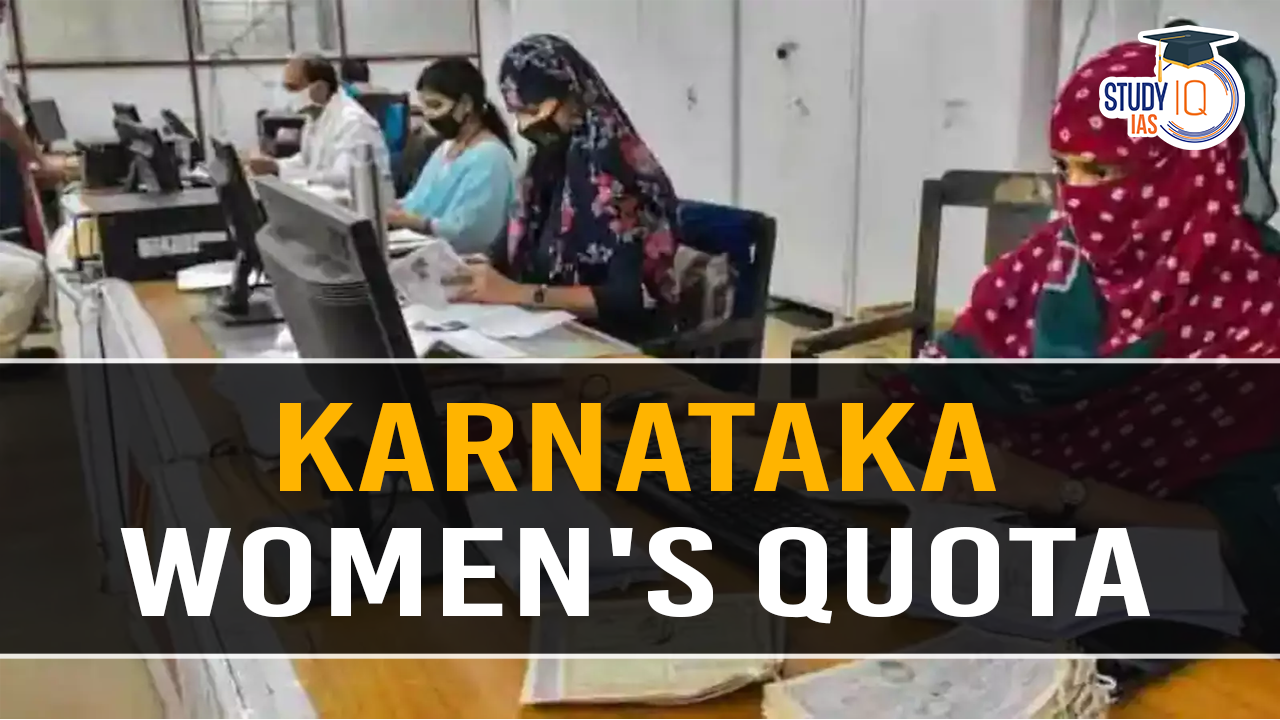Context: The Karnataka government has mandated a 33% reservation for women in services and posts outsourced by various government departments and organisations.
More In News
- Currently, over 75,000 employees hold outsourced jobs in government departments.
- The government typically hires third-party agencies to supply staff for Group C and Group D posts.
- Heads of all government organisations must include a clause mandating 33% reservation for women in the tenders/contracts for outsourcing services.
- The policy applies to outsourced jobs that last more than 45 days and employ over 20 people.
Women’s Reservation Bill 2023
Background
- 1980s: Women’s groups in India started demanding increased representation for women in elected bodies.
- 1989: The Rajiv Gandhi-led government introduces the first Women’s Reservation Bill, reserving one-third of all seats in rural and urban local bodies for women. The Bill became law in 1993.
- 1996: The H.D. Deve Gowda-led government introduces the Women’s Reservation Bill in Parliament, aiming to reserve one-third of Lok Sabha and state legislative assembly seats for women. The Lok Sabha passes the Bill, but it fails in the Rajya Sabha due to opposition from certain political parties.
- 1998 – 2003: The government tabled the Bill on 4 occasions but failed.
- 2008: The UPA government reintroduced the Women’s Reservation Bill in Parliament, and it passed in the Lok Sabha but failed in the Rajya Sabha.
- 2010: The UPA government introduced the bill again, but it was not passed by Parliament.
- 2014: The Lok Sabha is dissolved, causing the Bill to lapse.
- 2023: The Women’s Reservation Bill 2023 (Nari Shakti Vandan Adhiniyam) was introduced in Parliament by the Bharatiya Janata Party (BJP) government.
Key Features of the Women’s Reservation Bill
- Reservation for women: One-third of all seats in Lok Sabha (Article 330A), State legislative assemblies (Article 332A), and Delhi legislative assembly (Article 239AA) will be reserved for women.
- This will also apply to the seats reserved for SCs and STs in Lok Sabha and State legislatures.
| Note |
| The reservation will not be applicable to Rajya Sabha (Upper House) and State Legislative councils. |
- Commencement of reservation: The reservation will commence after the conduction of the next census. Based on the census, delimitation will take place to reserve seats for women.
- The reservation will be provided for a period of 15 years. It shall continue till such date as the Parliament shall determine.
- Rotation of seats: Seats reserved for women will be rotated after each delimitation, as determined by a law made by Parliament.
| Status of Women’s Reservation in Panchayats and Urban Local Bodies (ULBs) |
- In 1985, Karnataka became the first state to implement 25% reservation for women in Mandal Praja Parishads, with a sub-quota for scheduled caste and scheduled tribe women.
- In 1987, the erstwhile united Andhra Pradesh introduced 9% reservation for women in gram panchayats.
- In 1991, Odisha implemented 33% reservation for women in Panchayats.
- The 1992 Constitutional amendment made the 33% reservation quota national, including a sub-quota for scheduled caste and scheduled tribe women.
|
Important Facts Related to Women
- Global share of women MPs: 26.9%
- A country with the highest women representation: Rwanda (61.3%)
- India has ranked 127 out of 146 countries in terms of gender parity in the World Economic Forum Global Gender Gap Report.
- On political empowerment, India has registered 25.3 per cent parity, with women representing 15.1 per cent of parliamentarians.
- As per data released by the Election Commission of India, the number of women candidates contesting the Lok Sabha election had risen from 45 in 1957 to 726 in 2019.
- Women in leadership roles: India has one Woman Prime Minister, 2 female presidents and 15 Women have served as Chief Minister.
| 73rd and 74th Amendments |
- In 1992, based on the National Perspective Plan for Women 1988-2000, the 73rd and 74th Amendment Acts mandated the reservation of 1/3rd of seats for women in Panchayati Raj institutions (PRIs) and urban local bodies.
- Panchayat, as “Local government,” is a State subject and part of the State list in the Seventh Schedule of the Constitution of India.
- Article 243D of the Constitution ensures women’s participation in PRIs by mandating at least 1/3rd reservation for women of the total number of seats to be filled by direct election and the number of offices of chairpersons of Panchayats.
|
Sharing is caring!


 National Judicial Appointments Commissio...
National Judicial Appointments Commissio...
 GPS Spoofing and Its Impact in India: A ...
GPS Spoofing and Its Impact in India: A ...
 Amrit Gyaan Kosh Portal: A Comprehensive...
Amrit Gyaan Kosh Portal: A Comprehensive...





















